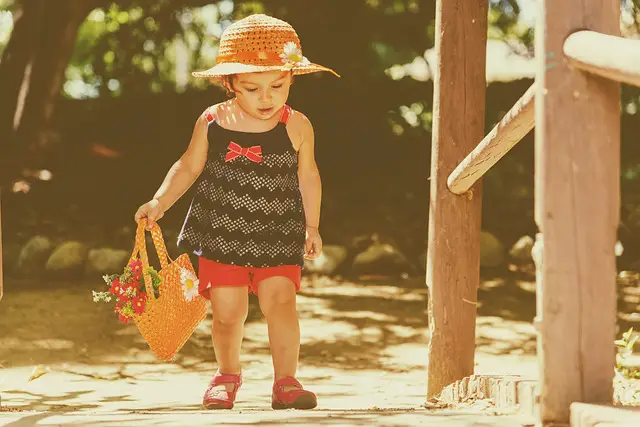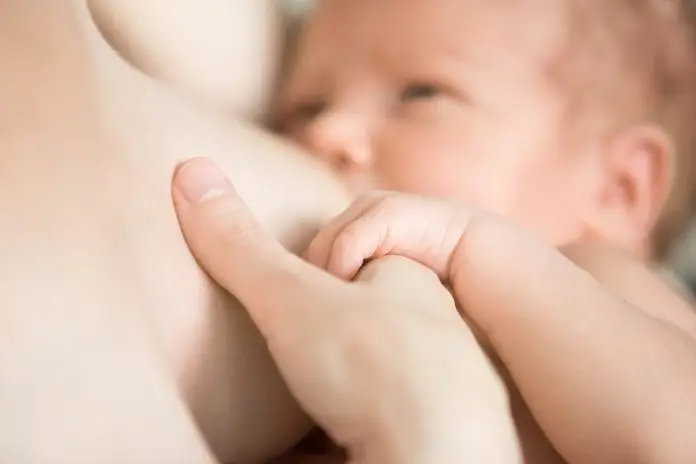When do babies walk? Baby’s first steps are always anticipated. While each child evolves at his or her own pace, there are still a few guidelines to help you watch your child’s development.
Like language acquisition, walking is not done at the same age for all children. Each child goes at his own pace. So there’s no need to worry. But, there are different stages of baby’s development that will give you some guidelines.
When Do Babies Walk Alone? The first step for Baby, a Big step for Mom
“In the psychomotor development of the infant, the transition to the sitting position occurs at about 6 months, the standing position at about 10 months, and the walking age on average at about 12 months… While knowing that there are possible variations in children! “recalls Dr. Rogers. Each child develops at his own pace.
Before he can walk, your little one will start by turning around, sitting down, and walking on all fours. Gradually, he will want to stand upright using the bars of his bed or the edge of the table.
There is no point in pressing him! Your child will feel himself when he is ready and when his legs are strong enough to support him… But, don’t hesitate to stimulate and strengthen his body by making him do a few small exercises!
The first steps usually occur between 10 and 18 months. In fact, only about half of the children can take a few steps on their first birthday.
Before walking, but, there are specific steps to take. Each one help to move on to the next step.
This is an important step for the child and his parents and requires great patience and perseverance. We explain what to do and what not to do when your child starts taking his first steps.
Stop asking the same question. When do babies walk alone? When do babies walk? When do babies start walking? just be patient!
The goal is also to make your little explorer understand that you will always be next to him, ready to take him in your arms again. We explain how to support your child’s first attempts and limit his or her insecurity and anxiety.
When do babies learn to walk?
A baby usually takes her first steps around her first birthday, but there are always early walkers and late walkers. As long as she’s hitting the following milestones, all systems go. If she is not progressing along these lines, talk to your pediatrician.
Getting into a sitting position Babies sit up on their own between four and seven months and then they topple over. Between eight and twelve months, they learn to get themselves into a sitting position on their own and stay there.
Crawling (or scooting and slithering) Off they go.
Now that they’re able to get on all fours, they figure out the forward motion (and sometimes backward motion, too). Babies crawl between seven and ten months. Some babies love crawling, and others do it briefly and then move on to more upright challenges.
And some babies don’t crawl at all they scoot around on their bottoms, they slither on their bellies, and they find other ways to get moving. However she does it, the main goal is for your baby to coordinate arm and leg movements on both sides of her body, which she’ll need to be able to do for walking alone.
Pulling into a standing position Up she goes, usually by grabbing onto you or a handy piece of furniture. Make sure furniture is secure and heavy enough for your baby to pull on—this is when the importance of baby-proofing really comes into play! “Cruising,” She “walks” by holding on to furniture.
When do baby walk unaided?
Her stroll may consist of the length of the living room sofa, but she’s getting ready. Stands without support. Look, Ma, no hands! She’ll stand without holding on to anything for a few moments at a time.
Very exciting for her, and for you. First steps The big moment is here! She’ll go from unassisted standing to a few forward steps. Now there’s no going back before you know it, she’ll want to see the world.
Some babies crawl, some scoot, and some roll. All of these are fine. Your baby has his own timetable. All babies have a big desire to get somewhere. This is a built-in desire that will lead to walking alone .
Babies are able to learn a lot more when they can explore their small world. Their world gets bigger as they go from hardly moving to crawl and then to walking. Every step leads to more things to hear, touch, taste, see, and smell.
A small mark on the floor might be very interesting to your baby as he returns, again and again, to try to pick it up. Your baby is really quite good at managing much of his learning development. He is very interested in figuring things out.
Let him take his time.
Make areas safe and be interested in what your baby is doing. Babies often enjoy being
funny and getting your attention. They like knowing that people pay attention to what they are doing. This gives them confidence, and they know they are important.
How to Encourage baby to walk unaided?
Around 8-10 months of age, babies start their period as a small explorers. He begins to want to stand up with the help of a table, chair or piece of furniture. You probably think it will work soon and you wonder this legitimate question: how to help baby walk?

Many parents are happy to see their baby stand up on his own or ask for help to get started. Parents see their baby take initiative, evolve, grow and want to be actively involved in this important stage of the development of a very young human being. What could be more normal for a parent than to want to know how to encourage baby to walk unaided
Many parents are happy to see their baby stand up on his own or ask for help to get started. Parents see their baby take initiative, evolve, grow and want to be actively involved in this important stage of the development of a very young human being.
What could be more normal for a parent than to want to help his or her baby walk?
In a desire to do well and please their baby, it can happen that some parents forget the main thing: babies learn to walk alone
So to help baby walk, there is only one thing to do: NOTHING! Here is the article is finished, have a good day. But no, butterfly minute, there are some interesting tips and tricks to know to act on your baby’s environment and develop his motor skills.
Baby feels ready
Walking acquisition varies from one child to another. Some will be able to walk as early as 1 year while others will start at 20 months. In addition, between the first steps and walking, it can take weeks.
The child must also have sufficient confidence and desire to start walking. It is therefore important to keep pace with it.
“Don’t go too fast. The child manages his or her motor development on his or her own as soon as he or she is doing well and has good tonicity,” explains a physiotherapist.
Creating Best conditions
To facilitate baby’s movements, you can arrange the space: place low and stable furniture on which he can lean, and remove fragile or dangerous objects…
At home, it is better to avoid slippers and start walking barefoot in order to have better sensations. The child must feel free in his or her movements. Lotus Baby Touch diapers are a practical option and perfectly adapt to the baby adventurer’s movements.
Encourage him without hurrying him
Sometimes there is a tendency to want to help the child take his first steps by holding his hands in the air. But according to Laurence Barone, it is better to let him do his walking experiments alone.
“If you hold your hands in the air, it does not strain the muscles used in a natural walk. The child is in hyper-extension. We create an asymmetry that unbalances it. But to learn, he needs to stabilize himself,” says the physiotherapist.
On the other hand, you can encourage him to walk by offering him toys to push or pull for example.
When Do Babies sit up?
Before the sitting position, when your baby is 5 months old, your child is able to turn around and move from his back to his stomach. Beforehand, doctors explain that “it is better to avoid putting the child in a sitting position alone for too long. He must be able to do it himself.”
. This will help it to build up muscle… At 5 months, you can straighten it up in a half-sitting position with cushions in the back in a “maxi-Cosi” or in a small deckchair… but always with the back support. As soon as he is able to sit up by himself, you can install him in his high chair.
when do babies crawl?
If the baby does not crawl or shows no benefit in moving around, it is legitimate to have some concerns. When should health services be consulted?
When babies are seated before they can sit alone, there is a risk of pressure on their spine. so they will have to lean on their hands.
where is the problem? they will not have the opportunity to use their hands to explore the world. if you sit too early, they will be seated and will be unable to change positions: they will not be able to lie on their backs or stomachs or crawl.
When a child is able to sit alone, it means that his or her spine is properly strong to support him or her.
If you want to help baby sit down, do it for a few moments only, make sure he or she doesn’t fall down (usually sideways) and that his or her back is well supported.
Thanks to the multiplication of his gross motor skills, your infant acquires a sense of balance, coordination and uses his large muscle groups, which allows him to control certain physical activities and see this linked file.
Over the next year, your infant will develop his gross motor skills by acquiring different skills, such as sitting, crawling, walking, running, climbing, jumping and everything his body allows him to do and which he generally prefers.
the development of gross motor skills facilitates a lot and the multiplication of fine motor skills.
Since some babies do not crawl and walk directly, there is no need to worry too much. However, if your baby has not crawled by 12 months of age, it is probably best to discuss this with your doctor.
Whether he crawls, crawls, crawls or whatever, you can easily help your baby to progress and gain self-confidence.
You can, for example, place his favorite toys a few steps away from him, to motivate him to come and try them out. It is also possible to put cushions.
for example, on his path, allowing him to correct his agility but it is imperative to supervise him to prevent any risk of an accident.
When should a baby stand?
From 8 months of age, the child hangs on to the furniture to stand up. To help him learn to stand up, there’s nothing like “the park!” It’s great for kids! They have their own little estate with all their toys. On the engine side, it helps them stand up, and know their limits.
they can also use the bars to stand up…” explains Dr. Le Conte. Many parents like to hold their child upright because it also amuses him a lot… but his lower limbs are still weak! To avoid tiring him out, don’t let him rest on his legs for too long.
When Do babies start to walk?
“Children usually start walking around 12 months of age. There’s no need to worry for two years! Anyway, When do babies walk alone? No worry, they’ll start walking when they’re ready…”, says Dr. Rogers.
As soon as your toddler starts walking, you can buy him good shoes… and think about making him sit down! Indeed, a 2-3-year-old child does not have the reflex to sit down!
At first, he may experience some muscle pain in his legs: cramps, aches, and pains. Nothing more normal if he gallops all day long! It is then up to you to play by making him “understand that you have to stop from time to time” to rest. As Dr. Rogers advises, you can
“Sit him down, tell him a story, and calm him down a little bit.” so that he doesn’t always stand upright. Because finally, he doesn’t stop moving, running… especially when he starts going to school. »




